Image of the ultrastructural morphology exhibited by the 2019 Novel Coronavirus (2019-nCoV). Credit: CDC
The onset of the COVID-19 pandemic had people sharing an array of strategies for disinfection and disease prevention. The ensuing months showed that the SARS-CoV-2 virus is primarily spread through the air via contaminated droplets, prompting a new wave of air purifying technology. A feature article in Chemical & Engineering News, the weekly newsmagazine of the American Chemical Society, details the various air purifier technologies and their efficacy against the coronavirus.
Although official guidance from the U.S. Centers for Disease Control and Prevention (CDC) suggests that social distancing and mask wearing are the most effective ways to prevent the spread of COVID-19 indoors, they also state that air purifiers can help reduce airborne contaminants, including viruses. These gadgets rely on various technologies, writes special correspondent Mark Peplow, and whereas some are proven to work, others require more data. Filtration with high-efficiency particulate air (HEPA) filters made from glass or polymer fibers is the most popular choice in hospitals and other clinical settings.
Another air purification method involves using ultraviolet C (UVC) light to deactivate viruses, including SARS-CoV-2, by making them unable to replicate. However, direct exposure to UVC can be harmful to people, which has led experts to suggest placing the lights in HVAC ducts, or lowering the intensity of the UVC light so that it can't penetrate living cells but can still kill airborne viruses. Another type of purification is known as bipolar ionization, which uses high voltage electrodes to create positive and negative ions from the air that can then attach to viral particles and prevent them from spreading. Although makers of ionization purifiers tout their ability to combat SARS-CoV-2, experts argue that the research has not been as convincing as that of other methods. Scientists agree that even with air purifiers, masks and social distancing should still be the first line of defense against the spread of SARS-CoV-2.
More information: The article, "Which air purification technologies can tackle COVID-19?," is freely available here: cen.acs.org/biological-chemist … s-tackle-COVID/99/i9
Provided by American Chemical Society
























